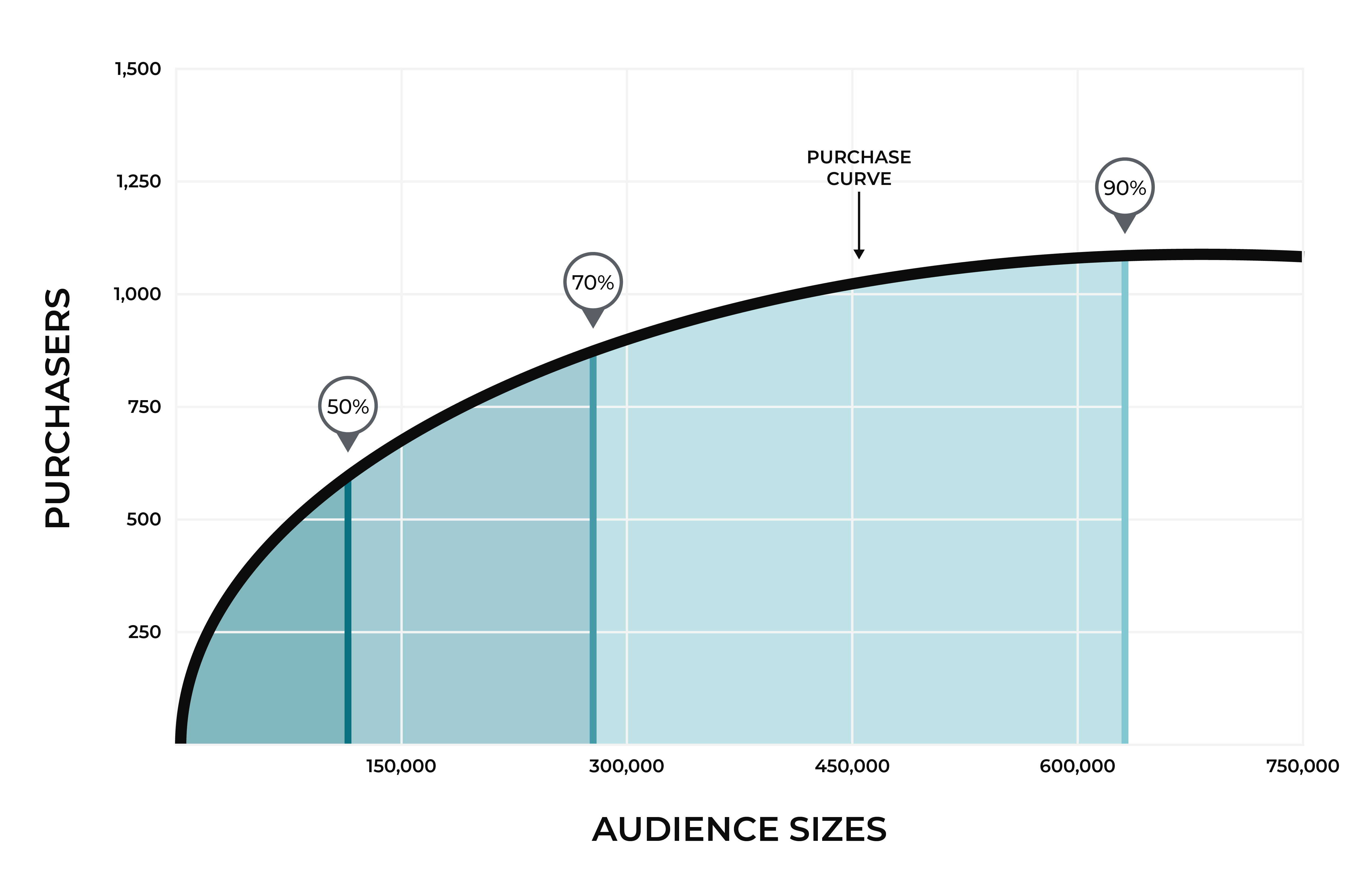Product affinity model¶
Product affinity is a predictive model that identifies which customers are likely to purchase by using a combination of historical purchase data and lookalike audiences. The predicted affinity model outputs a ranked list of customers with three recommended audience sizes.
Amperity models product affinity for any product taxonomy that contains between 20 and 2000 unique values, such as brand, category, subcategory, color, size, season, and style. Product affinity modeling analyzes:
Historical data to identify customers who have purchased a product in the past and are likely to do so again.
Lookalike audiences to identify customers who have not purchased a product, but are likely to buy because they are similar to customers who have purchased.
Use cases¶
The product affinity model enables support for marketing campaigns that benefit from knowing a customer’s preferences across product categories, including:
Recommended audience sizes¶
A recommended audience is a feature of Amperity that answers the following question: “Which audience size grows revenue over the next 30 days?” Amperity provides three answers to this question, in the form of recommended audience sizes: small, medium, and large. A small audience captures 50% of an audience, a medium audience captures 70%, and a large audience captures 90% of purchases for that audience over the next 30 days.
Recommended audience sizes are calculated using customer transaction data over a 30-day window. A purchase curve is generated, along with corresponding audience sizes that show what size audience would have been required to capture 50%, 70%, and 90% of purchases for a given product over the previous 30 days.
Audience sizes are inclusive of all smaller audience sizes.
A medium audience size (70%) includes all of your customers who are in the small audience size (50%).
A large audience size (90%) includes all of your customers who are in the small and medium audiences.

Recommended audience sizes identify customers who are most likely to purchase. Use recommended audience sizes to:
Engage with customers for product-specific sends, such as clearance sale and new arrival announcements
Define more valuable campaigns to grow revenue for specific product categories
Drive up conversion rates
Drive down opt-outs
Determine categories, products, and trends that resonate with key segments
Attributes for recommended audience sizes are available from the Predicted Affinity table:
Attribute Name |
Description |
|---|---|
Audience Size Small |
A small audience is predicted to incude ~50% of future purchasers, while including the fewest non-purchasers. Use a small audience size to help prevent wasted spend and reduce opt-outs. |
Audience Size Medium |
A medium audience is predicted to include ~70% of future purchasers, though it may also include a moderate number of non-purchasers. |
Audience Size Large |
A large audience is predicted to include ~90% of future purchasers, while also including a high number of non-purchasers. |
Combine these attributes with the Product Attribute attribute to build audiences for a specific product category, class, or brand. You can access these attributes directly from the Segment Editor.
Customer ranking¶
Use customer ranking to define an audience using the top N customers. Use customer ranking as an alternate to recommended audience sizes when an audience is too large (or small) or if a recommended audience size is unavailable for a specific product or category.
Customer ranking identifies the top N customers who are most likely to purchase. Use customer ranking to:
Provide an alternative to a recommended audience size, such as when a recommended audience size is unavailable for a specific product or category
Serve targeted product messages to defined audiences
Identify first-time buyer personas
Drive up conversion rates
Drive down opt-outs
The Ranking attribute in the Predicted Affinity table ranks customer scores by product. A rank that is less than or equal to X provides the top N customers with an affinity for this product. Combine this attribute with the Product Attribute attribute to build customer rankings for a specific product category, class, or brand. You can access this attribute directly from the Segment Editor.
Build a product affinity model¶
You can build a product affinity model from the Customer 360 page. Each database that is a “customer 360” database and contains the Merged Customers, Unified Itemized Transactions, and Unified Transactions tables may be configured for predictive modeling. You may use other tables in that database that are unique by Amperity ID to extend predictive models.
Important
The churn, pCLV, and affinity models start with a set of fields from the Merged Customers, Unified Itemized Transactions, and Unified Transactions tables from the database in which the model is built. EPM uses fields from Merged Customers, as well as the custom input tables selected during configuration.
The churn and pCLV models support custom input tables for transactions and transaction items. These tables should have the same field names as Unified Transactions and Unified Itemized Transactions, but can have custom logic, such as filtering or aliasing, depending on the data your brand wants to use to model churn and pCLV.
You may customize predictive models, such as excluding certain types of customers and adding custom features that support your brand’s use cases. Customer exlusions are based off of the Customer Attributes table, and custom features are based off of additional fields that may exist on Unified Itemized Transactions.
You do not need to configure the following fields:
Table |
Fields |
|---|---|
Merged Customers |
Predictive models always use the following fields in the Merged Customers table:
|
Unified Transactions |
Predictive models always use the following fields in the Unified Transactions table:
The following fields, when they are available in the Unified Transactions table, will also be used:
|
Unified Itemized Transactions |
Predictive models always use the following fields in the Unified Itemized Transactions table:
|
To build a product affinity model

|
Open the Customer 360 page, select a database, and then open the bottom– –menu and select Predictive models. This opens the Predictive models page. |

|
Next to Product affinity, click Add model. Select the product group for which the product affinity model will be built, and then click Continue. This opens the Predictive enablement page for product affinity models. |

|
Use the Customer exclusions field to use fields in the Customer Attributes table to identify customers who have purchase patterns that should be excluded from product affinity modeling. For example, use cases for customer exclusions include:
Note The list of fields in the Customer Attributes table that may be used for pCLV modeling are listed in the dropdown. Not all fields in the Customer Attributes table may be used with pCLV modeling. |

|
Use the Additional features field to add more fields from the Unified Transactions and Unified Itemized Transactions tables to the pCLV model. For each additional feature, the model results will include features for “first”, “last”, and “most common”. For example, if Product Category is added, the pCLV model results will include features for First Purchase Product Category, Last Purchase Product Category, and Most Common Product Category. |

|
Configure values. Use the Top N field to define the number of distinct values the product affinity model will be trained on, based on popularity in the last year. For example, a value of “50” means the product affinity model will be trainined on the 50 most popular values for the specified product category by number of purchases in the past year. Default value: “50”. Use the Exclude these values and Include these values fields to exclude or include specific values from the 50 most popular values. These entries are case-sensitive. For example: “purchase”, “Purchase”, and “PURCHASE” are three different values. |

|
Set product thresholds. Use the Last 30 days purchaser holdout field to set the number of unique purchasers that must exist within the last 30 days for a given product to appear in the audience size. Default value: “500”. Use the Last year purchaser field to set the number of unique purchasers that must exist within the last year for predictions to appear for a given product attribute. Default value: “1000”. |

|
Define audience sizes. Each size is defined as a percentage of the total number of customers in the audience that are required to meet an individual audience size. The product affinity model will select which customers need to be in the audience so that it captures each threshold within the next 30 days. Default values: “0.5” (small), “0.7” (medium), and “0.9” (large). |

|
Click Start validation. |
Use in segments¶
The following table describes the fields that are available when using product affinity modeling in segments.
Column name |
Data type |
Description |
|---|---|---|
Amperity ID |
String |
The unique identifier assigned to clusters of customer profiles that all represent the same individual. The Amperity ID does not replace primary, foreign, or other unique customer keys, but exists alongside them within unified profiles. Note The Amperity ID is a universally unique identifier (UUID) that is 36 characters spread across five groups separated by hyphens: 8-4-4-4-12. For example: 123e4567-e89b-12d3-a456-426614174000
|
Audience Size Large |
Boolean |
A flag that indicates the recommended audience size. When this value is A large audience is predicted to include ~90% of future purchasers, while also including a high number of non-purchasers. |
Audience Size Medium |
Boolean |
A flag that indicates the recommended audience size. When this value is A medium audience is predicted to include ~70% of future purchasers, though it may also include a moderate number of non-purchasers. |
Audience Size Small |
Boolean |
A flag that indicates the recommended audience size. When this value is A small audience is predicted to include ~50% of future purchasers, while including the fewest non-purchasers. Use a small audience size to help prevent wasted spend and reduce opt-outs. |
Product Attribute |
String |
The field against which product affinity is measured. For example: a category, a class, or a brand. |
Ranking |
Integer |
A ranking of customers by their score for this product. A rank that is less than or equal to X provides the top N customers with an affinity for this product. |
Score |
Float |
The strength of a customers’s affinity for this product, shown as an uncalibrated probability. Tip The score is used internally by Amperity, does not directly correlate to ranking or audience size, and should not be used in segments. Sort results by Ranking, and then compare those results to audience sizes. Higher rankings within smaller audience sizes correlate with stronger affinity. |